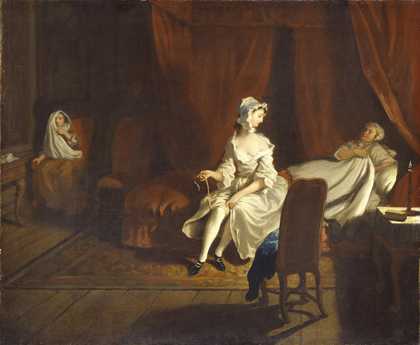
Joseph Highmore
VII: Pamela in the Bedroom with Mrs Jewkes and Mr B. (1743–4)
Tate
European painting in the eighteenth century is generally conceived as radiating from Paris. Rococo portraits and decorative mythologies invaded Germany, the Scandinavian countries and Russia; French influence was powerful in Rome and Spain.
As the French Revolution approached, France, in the person of Jacques Louis David, took over the leadership of the Neoclassical style (which perhaps originated in Rome), and established her primacy in the great movement which killed and succeeded the age of Rococo and Baroque.
The two great centres of resistance to this movement are generally held to be Britain and Venice.
It is true that British painting only achieved a national tradition during the eighteenth century, for the first time since its abandon of the international gothic tradition of the Middle Ages, but the sources of this new tradition are by no means, as is often supposed, only the Antique and the Italian Renaissance.
It is in the later 1720s that the first stirrings of a national style in painting appear. The young Hogarth, saturated with knowledge of contemporary French prints, painted the Beggar’s Opera; he went on to portrait conversations, and, in the 1730s, to his series of moral fables in paint.
Hogarth’s earlier style, although strongly personal, is an English variation on the style of Watteau and his contemporaries; his moral fables fit in exactly with that climate of thought which was to produce Diderot and the Encyclopedists.
At the close of the 1730s the change which comes over fashionable portraiture from mask to likeness was much promoted by the Frenchman JB Van Loo; the popular taste of the 1740s, which is most clearly seen in Hayman’s decorations for the Boxes in Vauxhall Gardens is equally an adaptation from French genre. The intermediary here was Hubert Gravelot, who, jointly with Hayman, ran the St Martin’s Lane Academy, where London painters got their training before the foundation of the Royal Academy in 1768. Gravelot had been a pupil of Boucher and his very numerous engravings for British illustrated books naturalised the straight French Rococo as the normal idiom for British painters and patrons.
It was from this ‘frenchified’ atmosphere of the 1740s that the young Gainsborough, perhaps the greatest potential genius among the British painters of the century, was to emerge. Although his gifts perhaps never achieved their full powers, Gainsborough is the one serious master of the English Rococo.
It was an age which demanded to have its portrait painted with legitimate pride, and no painter better fitted to bequeath to posterity a truthful but sympathetic series of historical images than Sir Joshua Reynolds has ever lived. It is easy to observe his defects of drawing and technique: easy to smile at his determination to invest his sitters with an air of tradition and importance by posing them, sometimes incongruously, in attitudes made famous by the masters of the past.
From the whole collection we can get a good picture of a vanished society, in which we can take a legitimate pride, and we can be proud of the painters too.
Ellis Waterhouse
